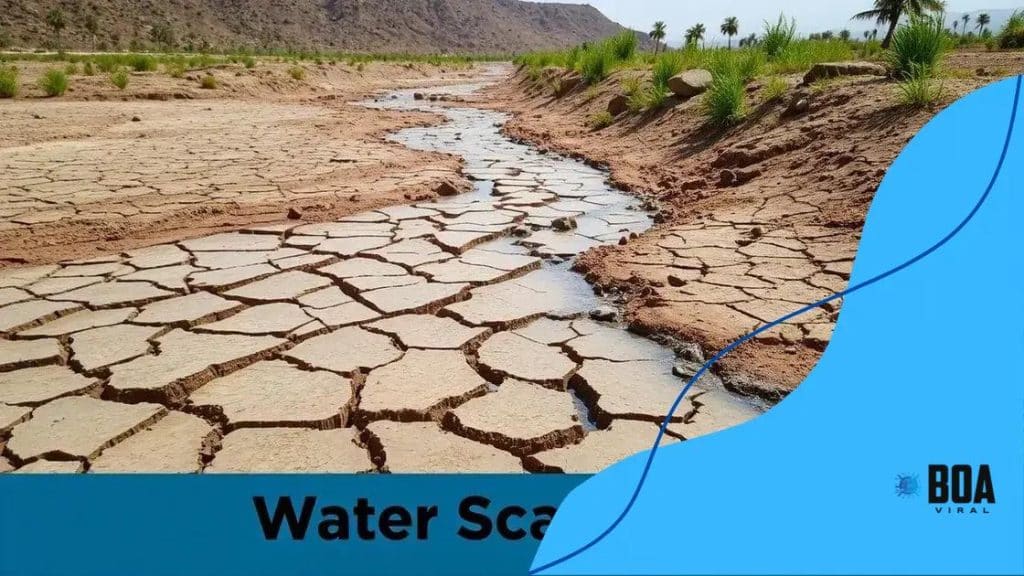Global water scarcity: urgent challenges and solutions

Global water scarcity poses significant challenges to communities and ecosystems, driven by factors like climate change and over-extraction, requiring innovative solutions such as smart technology and sustainable practices to address effectively.
Global water scarcity is becoming an increasingly pressing issue, affecting millions around the world. Have you ever considered how this crisis impacts our daily lives and future generations? In this article, we’ll delve into the challenges posed by water scarcity and explore practical solutions that can help us navigate this critical situation.
Understanding the causes of global water scarcity
Understanding the causes of global water scarcity is crucial for addressing this growing crisis. Water shortages affect us all, from local communities to entire nations, putting pressure on ecosystems and economies alike.
Natural Factors
Some causes are linked to nature itself. Climate change, for example, alters rainfall patterns and increases droughts. This leads to reduced water availability in various regions, creating challenges for agriculture and drinking supplies.
- Increased frequency of droughts.
- Rising temperatures affecting water sources.
- Changes in seasonal rainfall patterns.
Human Activities
However, human activities also significantly contribute to water scarcity. Population growth, urbanization, and industrialization place tremendous pressure on existing water resources. Cities expand, and more people need water, often leading to over-extraction from rivers and aquifers.
Additionally, pollution is a critical factor. When our rivers and lakes become contaminated, it reduces the amount of clean water available for use, further exacerbating the scarcity issue. Simple actions like proper waste disposal can have a significant impact on preserving our water sources.
Overuse of Water Resources
Overuse of water in agriculture is another significant contributor. Many regions depend heavily on irrigation to grow crops, leading to excessive withdrawal from water bodies. It’s essential to adopt more sustainable agricultural practices to protect these vital resources.
- Effective irrigation practices.
- Crop rotation to minimize water usage.
- Utilization of drought-resistant crops.
In conclusion, recognizing these diverse causes behind global water scarcity helps us formulate effective strategies for mitigation. Targeting both natural and human-related issues can pave the way for a sustainable water future.
Impact of water scarcity on communities and ecosystems
The impact of water scarcity on communities and ecosystems can be profound. When water resources become limited, entire populations face various challenges. Access to clean water is essential for drinking, sanitation, and agriculture, making it a critical issue for survival.
Effects on Local Communities
Communities often suffer from health issues when water scarcity occurs. Lack of clean water can lead to the spread of diseases. In many regions, families must travel long distances to find water, increasing their workload and affecting children’s education.
- Increased risk of waterborne diseases.
- Decreased agricultural productivity.
- Heightened economic strain on families.
Furthermore, social tensions can arise as communities compete for limited water resources. Conflicts over water can lead to disputes between neighbors and even escalate to larger-scale confrontations.
Impact on Ecosystems
The effects of water scarcity extend beyond human populations; they significantly impact local ecosystems. Aquatic habitats suffer when rivers dry up or water levels drop. Fish and other wildlife dependent on these water sources struggle to survive.
Additionally, plants that rely on regular water supply may wilt or die, leading to loss of biodiversity. This not only disrupts local ecosystems but also affects the food chain, as animals lose their natural habitats and sources of food.
Economic Consequences
Agriculture, a vital economic driver for many regions, gets hit hard by water scarcity. Farmers may lose crops due to insufficient irrigation, leading to reduced yields and income. This can have cascading effects, including rising food prices and economic instability in the area.
- Decline in local job opportunities.
- Loss of agricultural revenue.
- Increased costs for water alternatives.
Ultimately, addressing the impact of water scarcity requires comprehensive strategies that consider the needs of both human communities and the ecosystems that sustain them. Collaborative efforts can play a significant role in promoting sustainable water management practices.
Innovative solutions to combat water scarcity

Innovative solutions to combat water scarcity are essential in today’s world. As communities face increasing challenges, creativity in water management offers hope for a sustainable future. Technology and new practices can significantly improve how we conserve and use water.
Smart Water Management
One promising approach is smart water management. This method uses data and technology to monitor and manage water supplies effectively. Sensors and IoT devices can track water levels and usage in real-time, allowing for quick responses to changes.
- Leak detection to minimize waste.
- Optimized irrigation schedules for farms.
- Water usage analytics for households.
By utilizing these technologies, we can ensure that water is used efficiently and that losses are minimized.
Rainwater Harvesting
Rainwater harvesting is another innovative solution that can make a significant difference. Collecting rainwater can supplement local water supplies, especially in regions prone to drought. Simple systems can be installed in homes or community buildings.
- Systems range from barrels to large tanks.
- Reduces dependence on municipal water.
- Can provide water for irrigation and non-potable uses.
Implementing such systems not only conserves water but also promotes self-sufficiency.
Desalination Technology
Desalination technology is gaining traction in water-scarce areas, particularly in coastal regions. This process converts seawater into fresh water, providing an alternative source for communities struggling with supply.
While desalination is energy-intensive, recent advancements have made it more efficient and economically viable. Miniaturized desalination systems can also be deployed in smaller communities, bringing fresh water to those who need it most.
Efforts to raise awareness about water conservation practices are also crucial. Educating communities on simple actions, such as fixing leaks and using water-saving fixtures, can create a significant impact.
As we explore these innovative solutions to combat water scarcity, it’s clear that a combination of technology, proper management, and community engagement will pave the path towards a more sustainable water future.
Role of technology in water conservation
The role of technology in water conservation is becoming increasingly important. As the demand for water surges, innovative technologies are emerging to help us use this precious resource more efficiently. These advancements enable us to monitor, manage, and preserve our water supplies effectively.
Smart Irrigation Systems
One significant technological advancement is the implementation of smart irrigation systems. These systems use sensors and weather data to determine the ideal amount of water needed for irrigation. By optimizing water usage, these systems ensure crops receive the right amount of moisture without waste.
- Reduces overwatering and runoff.
- Increases crop yields and saves water.
- Adjusts watering schedules based on real-time data.
Farmers can therefore conserve water and enhance their productivity simultaneously.
Water Leak Detection
Another powerful technology in water conservation is advanced leak detection systems. These systems use sensors and smart meters to identify leaks in pipes and infrastructure. By detecting leaks early, communities can prevent water loss and reduce treatment costs.
Efficient leak detection contributes significantly to conserving water, ensuring that every drop counts. It’s especially essential in urban areas where aging infrastructure may be prone to leaks.
Desalination and Water Recycling
Desalination technology provides a new source of fresh water by removing salt from seawater. Although traditionally costly, advancements are making desalination more affordable and efficient. This technology can benefit coastal regions facing freshwater shortages.
Additionally, water recycling technologies capture wastewater and treat it for reuse. This process can provide water for irrigation, industrial uses, and even potable purposes, depending on the level of treatment. By reusing water, we reduce the demand for new supplies and alleviate pressure on freshwater sources.
Mobile Apps for Water Management
Mobile applications are also playing a role in promoting water conservation. Many of these apps offer tips for reducing water usage at home, track consumption, and encourage sustainable practices. They empower individuals and families to take control of their water usage.
As these technologies evolve, the potential for greater conservation grows. The integration of technological solutions into our daily water practices can lead to more responsible and sustainable water use.
Case studies of successful water management initiatives
Case studies of successful water management initiatives provide valuable insights into effective strategies for addressing water scarcity. These examples showcase how communities, governments, and organizations can come together to create sustainable solutions that benefit both people and the environment.
Singapore’s Water Management
Singapore is a leading example of innovative water management. Faced with limited natural water resources, the country developed a comprehensive strategy known as the “Four National Taps.” This approach incorporates local catchment water, imported water, desalinated water, and treated used water.
- Extensive rainwater harvesting systems.
- Advanced desalination plants.
- Reclamation of wastewater through NEWater facilities.
These efforts not only secure water supply but also promote conservation practices among citizens.
California’s Integrated Water Management
In California, integrated water management practices have evolved to address the challenges of drought and population growth. The state employs a combination of strategies, including groundwater replenishment and stormwater capture.
This integration allows various water sources to work together, ensuring a more reliable water supply while also protecting ecosystems. Initiatives like the Sustainable Groundwater Management Act encourage local agencies to manage groundwater more sustainably.
Australia’s Water Efficiency Programs
Australia has faced severe droughts, prompting the need for innovative water efficiency programs. Programs like the National Water Initiative focus on improving water use efficiency across agriculture, urban areas, and industry.
Education campaigns and incentives encourage businesses and households to adopt water-saving practices. Measures such as tiered pricing for water help promote conservation efforts among consumers.
Brazil’s Integrated Urban Water Management
In Brazil, the city of Belo Horizonte implements integrated urban water management to improve water quality and accessibility. This initiative involves restoring urban water bodies and creating green spaces that help manage stormwater.
By combining infrastructure development with community engagement, the city has successfully reduced flooding while enhancing the quality of life for residents. These holistic approaches showcase the potential for transformative outcomes in water management.
Through these case studies, we see that successful water management initiatives rely on collaboration, innovation, and community engagement. Learning from these examples can inspire similar efforts worldwide, emphasizing the importance of effective and sustainable water practices.
FAQ – Frequently Asked Questions about Global Water Scarcity and Solutions
What are the main causes of global water scarcity?
Global water scarcity is primarily caused by climate change, over-extraction of water resources, and pollution. These factors lead to decreased availability of clean water.
How can technology help in water conservation?
Technology aids in water conservation through smart irrigation systems, leak detection, desalination, and mobile apps that track water usage, promoting efficient practices.
What role do communities play in addressing water scarcity?
Communities can engage in water conservation efforts by participating in initiatives, educating others, and adopting sustainable practices to reduce water usage.
Can you give examples of successful water management initiatives?
Yes! Examples include Singapore’s innovative water management strategy, California’s integrated water management practices, and Australia’s water efficiency programs.






